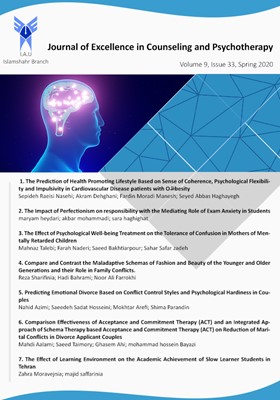Compare and Contrast the Maladaptive Schemas of Fashion and Beauty of the Younger and Older Generations and their Role in Family Conflicts.
Subject Areas : Journal of Excellence in Counseling and PsychotherapyReza Sharifinia 1 , Hadi Bahrami 2 , Noor Ali Farrokhi 3
1 - PhD student Department of Psychology, Science and Research Branch, Islamic Azad University, Tehran, Iran
2 - Professor of Department of Psychology, Science and Research Branch, Islamic Azad University, Tehran, Iran
3 - Associate Professor Assistance of Department of evaluating and Measurement, Allameh Tabatabai University, Tehran, Iran
Keywords: Family, Fashion, Beauty, maladaptive schemas,
Abstract :
Purpose: The Aim of this study was to compare and contrast the maladaptive schemas of fashion and beauty of the younger and older generations and their role in family conflicts. Methodology: The method of this study was causal-comparative. The statistical population consisted of all men and women aged 55-60 and boys and girls aged 16-20 in District 2 of Tehran, 15000 from whom 350 were selected by random sampling. In this study, the questionnaire of fashion and aesthetic schemas related to age and gender (Bahrami, Farrokhi and Sharifinia, 2019) was used. The statistical method of this research was factor analysis in the form of two-way variance analysis and the interactive effect between them. Results: The findings showed differences in aesthetic schemas between the ages of 20-16 and 60-55. The results also showed that there was a significant difference between the aesthetic schemas in people aged 16-and 55-60 living in Tehran in both sexes, and there was a significant difference between the two sexes in all aspects except for the beauty criteria, which led to many have been differences in families (P<0/05). Conclusion: In general, it can be concluded that most of the differences between today's young generation and the previous generation are the difference in their schemas. Schemas that may be inconsistent due to the impact of social media, satellite, the Internet and peers may cause major family disputes.
_||_


